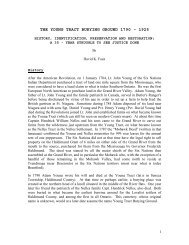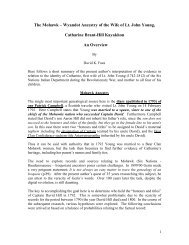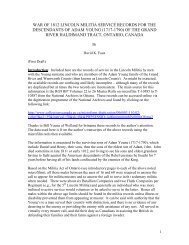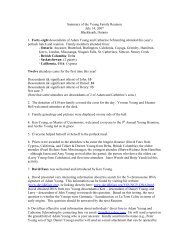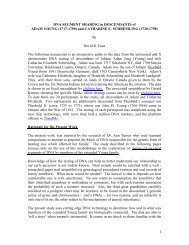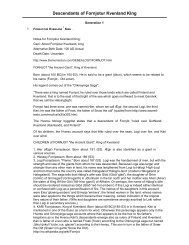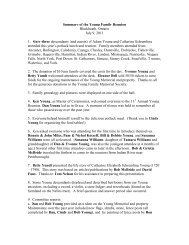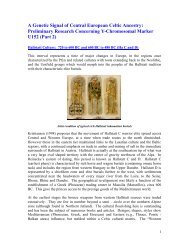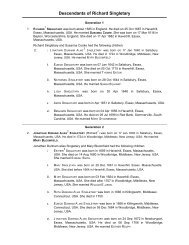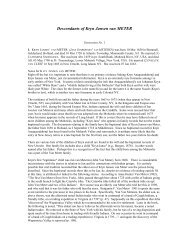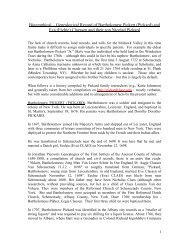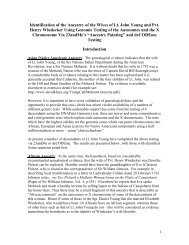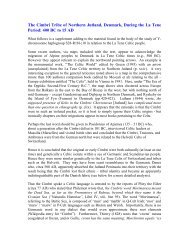Descendants of Hughes I de Cavalcamp Seigneur ... - Davidkfaux.org
Descendants of Hughes I de Cavalcamp Seigneur ... - Davidkfaux.org
Descendants of Hughes I de Cavalcamp Seigneur ... - Davidkfaux.org
Create successful ePaper yourself
Turn your PDF publications into a flip-book with our unique Google optimized e-Paper software.
Generation 3 (con't)<br />
Oct 1066: Hujus rei testes fuerunt, Rotbertus <strong>de</strong> Toieno et fratres mei, Osbernus<br />
<strong>de</strong> Callei et Rogerus pincerna <strong>de</strong> Vuatnevilla, Berengerius Spina ... + Signum<br />
Willelmi ducis Normannorum. + Signum Rotberti comitis <strong>de</strong> Ou. + Signum Willelmi<br />
dapiferi filii Osberni. Signum Radulfi <strong>de</strong> Toieno. + Signum Rogerii <strong>de</strong> Clera ... +<br />
Signum Berengerii Spinê. It seems from the double appearance <strong>of</strong> Berenger<br />
Spina that the subscriptions were ad<strong>de</strong>d on a different occasion from the<br />
attestations, presumably when ducal approval was obtained."<br />
From Stewart, "Musset (1978) 57 (table) showed a son <strong>of</strong> Berenger Spina also<br />
named Berenger, followed in this by Schwennicke (1989) 705. However, no<br />
source was cited for the person or the relationship and it appears to be a<br />
misplacement <strong>of</strong> Berenger [son <strong>of</strong> Robert] who is otherwise omitted.<br />
A Berengarius <strong>de</strong> Spineta attested a charter for Lyre abbey at the beginning <strong>of</strong> the<br />
12th century, see Le Prevost (1862-1869) ii 46-it is only a conjecture that this<br />
man’s father might have been Berenger Spina.<br />
The fanciful i<strong>de</strong>a was put forward in the mid-19th century that ‘Spina’ and its<br />
variants came about from a play on the imagined origin <strong>of</strong> the name Tosny, see<br />
Senex in N&Q (1861) xi 276-277: ‘That this last place [Thosny or Toëny] was<br />
named after their Norwegian name, Thorn or Thorny, <strong>de</strong>scendants <strong>of</strong> Thor, is<br />
evi<strong>de</strong>nt by the fact, that both the members <strong>of</strong> the Standard-bearer family, and<br />
also that <strong>of</strong> Robert <strong>de</strong> To<strong>de</strong>ni, <strong>of</strong> Belvoir, are known as De Spineto and De<br />
Spina, in numberless charters and other documents’. In fact the number is<br />
apparently small, just three charter occurrences <strong>of</strong> Berenger Spina or Hespina<br />
and this fourth case where an individual surnamed Spineta cannot be connected<br />
with any certainty to the Tosny family." (p.68-69)<br />
5. v. ROBERT DE TOSNY LORD OF BELVOIR was born about 1009 in pr. Tosny, Eure, Evreux,<br />
Normandy, France. He died on 04 Aug 1093 in Belvoir Castle, Leicestershire,<br />
England. He married ADELIZA FITZOSULF DU PLESSIS. She was born about 1025 in pr.<br />
Fresne, Normandy, France. She died before 1093 in Belvoir Castle, Leicestershire,<br />
England.<br />
Generation 4<br />
4. ROGER SEIGNEUR DE TOSNY ET CONCHES "THE 4 SPANIARD" (Ralph II <strong>de</strong> Tosny et 3 Conches, Ralph I<br />
<strong>Seigneur</strong> <strong>de</strong> Tosny et 2 Conches, <strong>Hughes</strong> I <strong>de</strong> <strong>Cavalcamp</strong> <strong>Seigneur</strong> 1 <strong>de</strong> Conches) was born<br />
about 990 AD in pr. Tosni, Eure, Evreux, Normandy, France. He died on 31 May 1043 in Lands<br />
<strong>of</strong> Humphrey <strong>de</strong> Vieilles, Normandy. He married UNKNOWN FIRST WIFE. She died about 1014. He<br />
married (2) GODEHILDE about 1025. She was born about 1010 in Normandy, France.<br />
Notes for Roger <strong>Seigneur</strong> <strong>de</strong> Tosny et Conches "The Spaniard":<br />
Wiki: Roger I <strong>of</strong> Tosny or Roger <strong>of</strong> Hispania was a Norman nobleman <strong>of</strong> the House <strong>of</strong> Tosny<br />
who took part in the Reconquista <strong>of</strong> Iberia. He was the son <strong>of</strong> Raoul I <strong>of</strong> Tosny.<br />
In 1013, Roger and his father Raoul I guar<strong>de</strong>d the castle at Tillières for Richard II, Duke <strong>of</strong><br />
Normandy. A few years later, for an unknown reason, the pair were forced into exile. While his father<br />
gained a reputation for himself in Apulia, Roger did the same in fighting the Muslims in Iberia. The<br />
small Christian states <strong>of</strong> Northern Iberia welcomed volunteers and adventurers who they could use<br />
to mount a strong force for the Reconquista. Roger was summoned by Ermesin<strong>de</strong> <strong>of</strong> Carcassonne,<br />
regent-countess <strong>of</strong> Barcelona after the <strong>de</strong>ath <strong>of</strong> her husband Ramon Borrell, to help her against the<br />
Muslim threat to her power. Roger rushed to help, marrying Ermesen<strong>de</strong>'s daughter, terrorising the<br />
Saracens and capturing several towns and castles. Adémar <strong>de</strong> Chabannes gives an echo <strong>of</strong> the<br />
more or less legendary <strong>de</strong>eds <strong>of</strong> Roger in Iberia. He gained the



